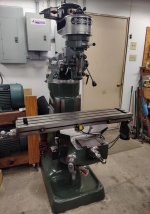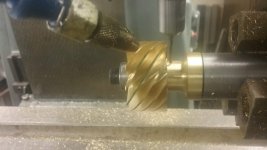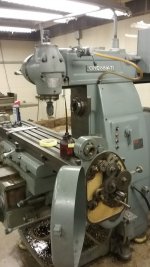M.B. Naegle
Diamond
- Joined
- Feb 7, 2011
- Location
- Conroe, TX USA
I've had a couple other threads related to this mill, but wanted to bring it all together.
So this mill is a 1936 Cincinnati 2L horizontal with the universal table, but we'll go back a little in the history books first.
My dad grew up on a horse ranch and decided he didn't want to shovel manure anymore, so out of high-school he shifted carriers and went to work in some saddle shops. That took him a few different places making harness, building and restoring antique steamer trunks, and he worked as a props and special effects man in Hollywood for a number of years, specializing in fitted leather flying harness's. If you've ever seen 'Hook' with Robin Williams, my dad's the guy who connected the flying wires to him, and did such a good job that you couldn't see his work.
As years went on, Dad got to where he liked working on the machines more than using them, which eventually lead us to our present family business. Before I was born, we had a neighbor who had retired from making gauges for the aircraft industry (old school aerospace) by the name or Irwin A. Spalding. I don't know his full history, only that he worked for Wright aircraft for awhile and helped make plains during WW2. He had a little shop in is garage that he had done contract aerospace work with before retiring, and he taught my dad the basics of machining. Afterwards he offered to sell his tools to my dad and that was the beginning of our machine shop.
In that lot, there was a little 9" South Bend, and an 11" Delta Rockwell lathe, both outfitted for both standard toolroom work as well as turret lathe work, and with them was the Cincinnati. When we got it, it was missing the cast overarm and instead had a stubby plate steel assembly there that had a Tree vertical head attached to it. The main spindle motor had also been replaced with a 220v single phase motor so Irwin didn't need 3 phase in his shop. We got a lot of use out of that set-up until we bought our first CNC mill in 2000 and needed some room. The Cincinnati did a few jobs still including line boring some small iron frames, but ended up in storage.
Then in 2011, I had finished school, gotten married, and went to work full time. One of my afterhours tasks was consolidating our storage space down, which included setting up as many off-line machines as I could make space for, and selling the ones we really didn't need (had some redundancy after merging 3 manual shops together and adding CNC to the mix). The Cincinnati went back to work and a fellow PM'er gratefully hooked me up with an original cast over arm and arbor support. The Tree milling head had a couple issues and I decided to sell it for parts, as we had several Bridgeport mills around the shop. Had a fantastic time using the mill until around 2015 I noticed the spindle bearings were starting to get crunchy (Spindle Bearing Thread). Around the same time, we built a new shop in Conroe Texas and moved everything there over the next 5 years (kept the old shop for storage for a little while). In that time, I switched over to using our Kearney Treker 2H at work (K&T thread) and had "when-I-get-around-to-it" plans to set up the Cincinnati at home, which never happened. Eventually I decided as much as I like both mills, I didn't have the space or needs to keep both, so I decided to part with the K&T and get the Cincinnati back in shape, which is where we are at today.
I've got the Cincinnati set up beside the K&T at the moment, briefly before the K&T gets loaded up and taken to it's new home up in north Texas. In addition to just cleaning it up and changing oil, I'm taking the opportunity to freshen up the paint (before it's soaked in cutting oil again), and I'm re-doing the old Tree head's welded steel mounting bracket to clamp under the end of the overarm dovetail, and mounting a little Bridgeport M-head to it which I picked up awhile back. It's in decent shape, but missing the motor, so I needed to find another cone pulley for it (Step Pulley Thread), to graft to a C-face 1 HP single phase motor. What I'll likely do is use the single phase motor set on my M-head Bridgeport at home and use that mills 3 phase motor set on this mill. The head going on this mill is a Morse #2 taper, while the other at home is a B&S #7.
I had also started rounding up scales to put a 3 axis Acurite DRO on the K&T, but will instead put them towards this mill eventually. The newest addition is I finally got my hands on a Cincinnati planetary indexer with PTO shaft input! Had wanted one for a long time and finally found one for a good deal. A project for later will be putting together a set of gears, shafts and brackets to do helical gears on this mill. Before then, I'll need to locate a tail-stock for the indexer, but I have a generic adjustable one to use in the mean-time.
(I'm having a hard time getting photo's to load.... Got a couple sized down and adjusted to low pixel'y quality, and still "too large" to load!!!)
So this mill is a 1936 Cincinnati 2L horizontal with the universal table, but we'll go back a little in the history books first.
My dad grew up on a horse ranch and decided he didn't want to shovel manure anymore, so out of high-school he shifted carriers and went to work in some saddle shops. That took him a few different places making harness, building and restoring antique steamer trunks, and he worked as a props and special effects man in Hollywood for a number of years, specializing in fitted leather flying harness's. If you've ever seen 'Hook' with Robin Williams, my dad's the guy who connected the flying wires to him, and did such a good job that you couldn't see his work.
As years went on, Dad got to where he liked working on the machines more than using them, which eventually lead us to our present family business. Before I was born, we had a neighbor who had retired from making gauges for the aircraft industry (old school aerospace) by the name or Irwin A. Spalding. I don't know his full history, only that he worked for Wright aircraft for awhile and helped make plains during WW2. He had a little shop in is garage that he had done contract aerospace work with before retiring, and he taught my dad the basics of machining. Afterwards he offered to sell his tools to my dad and that was the beginning of our machine shop.
In that lot, there was a little 9" South Bend, and an 11" Delta Rockwell lathe, both outfitted for both standard toolroom work as well as turret lathe work, and with them was the Cincinnati. When we got it, it was missing the cast overarm and instead had a stubby plate steel assembly there that had a Tree vertical head attached to it. The main spindle motor had also been replaced with a 220v single phase motor so Irwin didn't need 3 phase in his shop. We got a lot of use out of that set-up until we bought our first CNC mill in 2000 and needed some room. The Cincinnati did a few jobs still including line boring some small iron frames, but ended up in storage.
Then in 2011, I had finished school, gotten married, and went to work full time. One of my afterhours tasks was consolidating our storage space down, which included setting up as many off-line machines as I could make space for, and selling the ones we really didn't need (had some redundancy after merging 3 manual shops together and adding CNC to the mix). The Cincinnati went back to work and a fellow PM'er gratefully hooked me up with an original cast over arm and arbor support. The Tree milling head had a couple issues and I decided to sell it for parts, as we had several Bridgeport mills around the shop. Had a fantastic time using the mill until around 2015 I noticed the spindle bearings were starting to get crunchy (Spindle Bearing Thread). Around the same time, we built a new shop in Conroe Texas and moved everything there over the next 5 years (kept the old shop for storage for a little while). In that time, I switched over to using our Kearney Treker 2H at work (K&T thread) and had "when-I-get-around-to-it" plans to set up the Cincinnati at home, which never happened. Eventually I decided as much as I like both mills, I didn't have the space or needs to keep both, so I decided to part with the K&T and get the Cincinnati back in shape, which is where we are at today.
I've got the Cincinnati set up beside the K&T at the moment, briefly before the K&T gets loaded up and taken to it's new home up in north Texas. In addition to just cleaning it up and changing oil, I'm taking the opportunity to freshen up the paint (before it's soaked in cutting oil again), and I'm re-doing the old Tree head's welded steel mounting bracket to clamp under the end of the overarm dovetail, and mounting a little Bridgeport M-head to it which I picked up awhile back. It's in decent shape, but missing the motor, so I needed to find another cone pulley for it (Step Pulley Thread), to graft to a C-face 1 HP single phase motor. What I'll likely do is use the single phase motor set on my M-head Bridgeport at home and use that mills 3 phase motor set on this mill. The head going on this mill is a Morse #2 taper, while the other at home is a B&S #7.
I had also started rounding up scales to put a 3 axis Acurite DRO on the K&T, but will instead put them towards this mill eventually. The newest addition is I finally got my hands on a Cincinnati planetary indexer with PTO shaft input! Had wanted one for a long time and finally found one for a good deal. A project for later will be putting together a set of gears, shafts and brackets to do helical gears on this mill. Before then, I'll need to locate a tail-stock for the indexer, but I have a generic adjustable one to use in the mean-time.
(I'm having a hard time getting photo's to load.... Got a couple sized down and adjusted to low pixel'y quality, and still "too large" to load!!!)








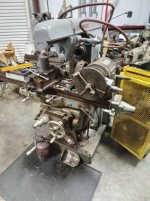



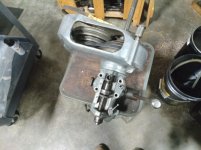
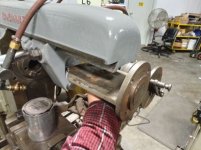
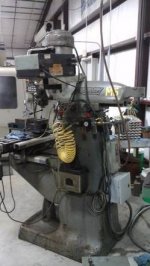

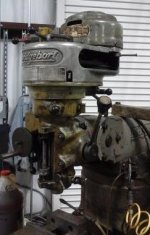
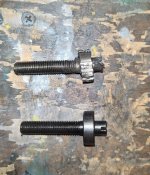
 , so I want machines to get me close first. Prior to all that, I had serviced the motor and head a bit, so that works very nice.
, so I want machines to get me close first. Prior to all that, I had serviced the motor and head a bit, so that works very nice.
